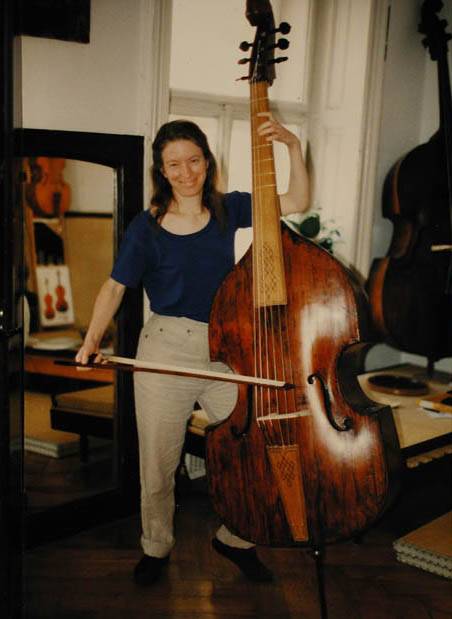Orpheon's
*** Playmate of the Month ***
Playmate Nr. 1

This is my friend, Alice Robbins, from Massachussetts. She is a professional viol player.
NO, NO, NO! SHE is NOT the playmate of the month. I know what you all were thinking!
The real "Playmate of the Month" is the big brawny brute with the rudy complexion proudly standing on her left. As you see, Alice is in fact tenderly caressing his long neck...
When she caught a glimpse of this marvellous specimen at my home in Vienna, Alice just could not keep her hands off him. When she first drew the bow across those taut, sinewy strings, it was love at first rub! She adored that sonorous voice in the depths of the bass region....."
Our "playmate of the month" - this magnificent violone - was built in the 17th C. in the Veneto Region of Northern Italy (near Venice). It represents the largest member of the viola da gamba family, tuned like a bass viol, but one octave lower (DD, GG, C, E A. d), thus playing the sixteen-foot register.
What exactly is a violone?
The Italian word "violone" means literally "a big viola" or "a large stringed instrument". In the course of history the term has been used to denote any of the following instruments: a normal bass viola da gamba, a large violoncello, a normal violoncello, a six-stringed viola da gamba in G (one fifth below the bass viol), a six-stringed viola da gamba in D (one octave below the bass viol, like our "playmate"), a normal double-bass of four strings, a double-bass of three strings, a double-bass of five strings. So when a composer writes "violone" on his score, no one can be certain which of these many instruments he actually had in mind. In order to make an intelligent choice, one needs to know much more: the date of composition, the place, the orchestration of the work all could yield clues.
The proper - more specific - designation of this instrument would be "Contrabasso di viola da gamba".
We employ this violone with our viola da gamba consort, whenever the sixteen-foot register is required, or in combination with baroque string ensembles in the performance of Italian and German works of the 17th C., particularly Claudio Monteverdi (who was himself a viola da gamba virtuoso!), Schütz, and the subsequent generations all the way to Bach. With its warm, noble sound - never rude, never uncouth - the violone bestows a fine touch of majesty to the whole ensemble.
Truly a great playmate!
Look at our violoni:
Italian (Venetian, 17th C.) 6 strings in D
Johann Georg Thir (Vienna, 1750) 5 strings
Johannes Udalricus Eberle (18th C.) 4 strings
German (18th C.) 6 strings in G
updated